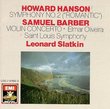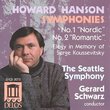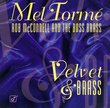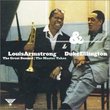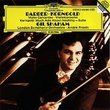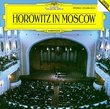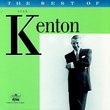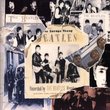| All Artists: Ned Rorem, José Serebrier, Bournemouth Sinfonietta, Bournemouth Symphony Orchestra Title: Rorem: Three Symphonies Members Wishing: 0 Total Copies: 0 Label: Naxos American Original Release Date: 1/1/2003 Re-Release Date: 8/19/2003 Genre: Classical Styles: Historical Periods, Modern, 20th, & 21st Century, Symphonies Number of Discs: 1 SwapaCD Credits: 1 UPC: 636943914922 |
Search - Ned Rorem, José Serebrier, Bournemouth Sinfonietta :: Rorem: Three Symphonies
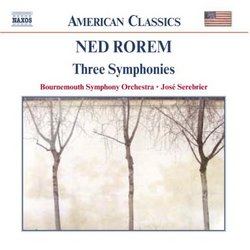 | Ned Rorem, José Serebrier, Bournemouth Sinfonietta Rorem: Three Symphonies Genre: Classical
Universally recognized as a great master of modern song-writing, Rorem has always continued composing orchestral music but has received few performances, writing, as he has, in a tonal idiom alien to the atonal and experim... more » |
Larger Image |
CD DetailsSynopsis
Album Description Universally recognized as a great master of modern song-writing, Rorem has always continued composing orchestral music but has received few performances, writing, as he has, in a tonal idiom alien to the atonal and experimental practices of the day. When Leonard Bernstein gave the first performance of Rorem?s Third Symphony with the New York Philharmonic in 1959, it signaled a significant triumph for his orchestral music, but the path ahead would remain thorny. When the now famous diaries were published, it brought Rorem a great deal of notoriety and controversy, but it did not translate into performances of his orchestral music. Respected and admired by colleagues, Rorem has continued writing the kind of music that he believes in, and over the past decade, with the universal change in composing styles, performances of his music have mounted constantly. ? José Serebrier Similarly Requested CDs
|
CD ReviewsSymphonies That Should Be Better Known J Scott Morrison | Middlebury VT, USA | 08/22/2003 (5 out of 5 stars) "Ned Rorem (b. 1923) has long-been known as the composer of some of the loveliest and most effective American art songs ever written. The Elektra/Asylum CD of a couple of years ago by Susan Graham, mezzo, accompanied by Malcom Martineau and the Naxos CD by soprano Carole Farley accompanied by the composer even more recently are eloquent testimony to that fact. I wouldn't be without either of them. And just a few months ago we got a magnificent CD of Rorem chamber music, also from Naxos. But here we get a big taste of Rorem's orchestral compositions--three symphonies no less--and I'm here to tell you that they are Important Pieces; their neglect up to now is simply shameful. I keep perhaps tiresomely reiterating how grateful we should be to Naxos for bringing things like these symphonies to us. But practically every month there is a release like this one--wonderful American classical music that we've never heard before, often never even heard OF before, and in superb performances. These three tonal symphonies were all written in the 1950s at a time when the academic mafia was gearing up to brainwash us into thinking that tonal music was unnecessary, even subversive somehow. I remember derogatory comments being made back then that American tonal music was somehow kin to the state-mandated tonal 'music for the masses' from the Soviet Union. Although Rorem's Third Symphony was premièred by Leonard Bernstein, got some play initially and had a fine recording by the Utah Symphony back in LP days, none of these three has been taken up in any significant way by American (or other) orchestras. This may partly have been because Rorem was subconsciously characterized as 'just' a song composer. Whatever the reason, Naxos is righting that wrong by bringing out this spectacular issue of the three symphonies played by the wonderful Bournemouth Symphony under the direction of American conductor José Serebrier, long a champion of Rorem's music. Serebrier's notes in the enclosed booklet are eloquently informative.I can only recall one other recording of Rorem's orchestral music. That was by the Atlanta Symphony under Robert Shaw and Louis Lane and included the wonderful 'Eagles,' long a favorite of mine. If there are others, they haven't come my way.So, I was very surprised and pleased to realize how stirring these three symphonies are. It was no surprise that Rorem can write a long, lyrical line--he's done that plenty in his songs--but his handling of symphonic form, including contrapuntal passages, motivic development, rhythmic interest, exciting fast music (not something I'd associated with him), and masterful orchestration simply bowled me over. In fact, I kept starting to write this review, but kept going back to listen to the symphonies once again. And I kept finding wonderful things to write about, e.g. the hypnotic insistence of the four-note passacaglia theme in the first movement of the Third, the pizzicato passages in the finale of the Third, the maestoso brass chorale opening the Second, the long, lyrical and complex first movement of the First, the gently melancholy second movement with its French tinge--amazing what can be done with a simple triad!Now, Naxos, can we have a new recording of 'Design for Orchestra', once recorded, I seem to recall, by the Louisville Orchestra and how about the incidental music for Tennessee Williams's 'Suddenly Last Summer,' and 'The Milk Train Doesn't Stop Here Anymore'? Otherwise, I'll have to go cold turkey and it won't be a pretty sight. Highly recommended.TT=69:22Scott Morrison" Fabulous Symphonies D. A Wend | Buffalo Grove, IL USA | 08/23/2004 (5 out of 5 stars) "It is strange that only the Third Symphony of Ned Rorem has been previously recorded. Rorem's symphonies were written in the 1950s when atonal music was the direction most composers were exploring. Hence these lyrical masterpieces tended to be performed and forgotten. Mr. Rorem described the First symphony as a suite. It was completed in 1950 and was performed the next year. The music is characterized by lush melodies, seeming to describe nature. The influence of French composers, like Faure (particularly in the pastoral opening) is very apparent. As is the prominent use of flute and oboe solos in the orchestration but all this is taken by Mr. Rorem in his own direction. There is mystery and pastoral charm in the Largo that is balanced against the playful charm of the Allegro Finale. This is an appealing symphony that is astonishingly beautiful. The Second Symphony has been performed less frequently than the First and Third. Composed in 1956, it has a long first movement (over 15 minutes) that is dramatic in character. The symphony takes off with a short theme played by the full orchestra then develops into a somber interlude played by the strings and woodwinds. Eventually, the bassoons initiate a more playful theme that is carried through the entire orchestra with a snare drum tapping out a staccato rhythm. The movement returns to a pastoral theme played by the strings and woodwinds. The final two movements are just over 3 minutes each. The Tranquillo movement is reminiscent of Aaron Copland in the quiet, song-like music and the finale is an exuberant scherzo movement with a nice part written for piano. The appeal of this symphony is certainly the equal of the other two. The Third Symphony was first performed in 1959 conducted by Leonard Bernstein and is cast in 5 movements. It is a work abundant with beautiful pastoral melodies, playful dance tunes and orchestra fireworks - a well-balance and tuneful symphony that is immediately appealing. The final movement its dance-like melodies and skillful use of the orchestra is very appealing. What I find appealing about these symphonies are the introspective quiet melodies that seem to be describing peaceful landscapes and the joyous, playful tunes that balance the music. It is music that communicates to the listener is a personal way. Ned Rorem has a way of orchestrating that appeals to the listener with the overall effect. There may not be a tune that one will take away but the experience is nonetheless satisfying. These symphonies were immediately appealing to me and I have played them often since the first time I heard them. I hope that other listeners are just as curious as I was. " The essences of Rorem?s music blossoming before our eyes. David A. Hollingsworth | Washington, DC USA | 09/29/2003 (5 out of 5 stars) "The music of Ned Rorem, other than his songs, has not fared well in the catalogue (and in the concert halls for that matter). Despite the advocacy of Bernstein, Serebrier, Schwarz, Zinman, Slatkin, Tilson-Thomas, Alsop, Kuchar, and even Whitney & Mester especially in the music of Walter Piston, American classical music is still under-performed in concert halls and in the theatres (Hanson's "Merry Mount" have yet to be performed and recorded in our digital age). Even radio stations are for the most part could have done more on their parts in that regard. But the tides are turning in its favor, thanks to recording labels such as Naxos, Chandos, First Edition Music, and Sony Classical in giving us the exposure truly deserving to the immense talents these American composers possess and their pioneers who recorgnize them. Though recordings do not necessarily mean the music's entry into public performances, such an enterprising venture of these artists and recording companies is a good enough start.Ned Rorem, far more of a prolific composer than the recordings would suggest, is more recognized as a great composer of songs. But his symphonies are impressive in their own right, not just in terms of the orchestration, which is as vivid as, say, Benjamin Frankel's, but his ideas and manipulation of them shows him as a composer of ingenuity. I really like the Passacaglia opening movement of the Third Symphony (1958). The gesture is bold and majestic, pretty much in the neighborhood of Copland and for a moment Leonard Bernstein's film music for "On the Waterfront" (especially for the final scene where after Terry Malloy conquered corruption, he enters triumphally into the loading docks followed by his fellow workers). But listen to the Allegro molto vivace movement and you're witness something of pure enjoyment. It's almost like riding cheerfully throughout the countryside and nothing but American pride deep in one's subconsciousness. The Largo movement is too short for my taste, but it has introspection along with dignity and that sense of determination. But the mood seems a bit more uplifting in the Andante; not melancholic per se, but reflective of things of inner beauty and tranquillity. It is a beautiful, graceful movement, sort of pastoral in veins similar to Vaughan-Williams and, again, Copland. The finale is as spirited as second movement, with the orchestration compellingly virtuosic and vivid. But at 3:23, the writing becomes majestic & a bit inward looking, at least for a brief moment, until the playfulness returns.Rorem's First Symphony (1950) begins with a fanfare of the brass then woodwinds. The Maestoso movement is wonderfully dignified, but with an added gracefulness and nobility announced especially by the harp. But the middle slow movements (Andantino and Largo) are praiseworthy here. They're poised and pensive, cool in its temperaments, but neither troubled or shallow for that matter. The mood is not absent-minded, but forward looking. The finale is quite forward looking also, captivatingly so, with its rhythmic bite reminding me of Paul Creston (whose symphonies are equally enjoyable). The complex first movement of the Second Symphony (1956) is particularly striking. The mood is more inward-looking than it is an extroversion, even in faster, more vivid passages. Hanson comes to mind at various points in the long lyrical yet lovely lines. The gracefulness of the second movement is inescapable, with the writing more simpler and straightforward. The finale is a bit disappointing though, for Rorem could've develop those vivacious ideas even more. But, overall, this symphony, as with two others, deserves a more wider recognition. And Jose Serebrier remains sort of this landmark type conductor who brings underrated music into a more wider recognition. As with his greatly acclaimed performance of Charles Ives Fourth Symphony (now under the RCA/BMG label) and more recently Janacek's orchestral works (Reference Recordings label), Serebrier has this penchant of details and colorful shapings. There's nothing at all bland in his treatment of the Third Symphony's Passacaglia movement. It's is wonderfully shaped and majestic, very much of how Bernstein would have approach the score. Even Serebrier's ways with the faster movements shows real imagination and verve, and like Schwarz, shows the underlying warmth and the gay-like innocence within. But, for me, Serebrier's treatment of the slow movements is the more special. In the middle movements of the First, the projection of that inner beauty and pensiveness becomes breathtaking and arresting. And I admire how he brings out the "longingness" of the complex first movement of the Second and then comes back and brings out the picturesque outward looking yet dreamy qualities of the next movement. The Bournemouth Symphony Orchestra comes up huge as well, with its percussion section especially superb & compelling (and adds greater point to the overall articulation). The strings are illuminating and of real bloom while the winds are well blended. It is a towering achievement of all involved & hope for Serebrier to turn to Rorem's other orchestral works like his Double Concerto for Violin and Cello. Serebrier's program note is admirable and a testament of a true advocate while recording quality is splendid. Recognition of Rorem's music is coming into a more fuller bloom.......finally."
|

 Track Listings (12) - Disc #1
Track Listings (12) - Disc #1
